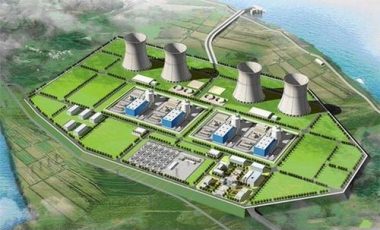| Tuesday, 24 August 2010 | |
energiterbarukan.net- PT Pertamina Geothermal Energy (PGE) memerlukan US$2 miliar atau sekitar Rp18 triliun untuk mengembangkan pembangkit listrik tenaga panas bumi (PLTP) dengan kapasitas 1000 megawatt (MW) pada 2014.
Direktur Utama PGE Abadi Poernomo mengatakan kebutuhan pendanaan sebesar itu akan dipenuhi dari pinjaman dari luar negeri seperti Inggris, Prancis, Jerman, Jepang, dan Bank Dunia. "Kami membutuhkan US$2 miliar atau Rp18 triliun, itu akan kami penuhi dari pinjaman,"ujar dia di Jakarta Selasa 24 Agustus 2010.
Abadi menjelaskan, dalam waktu dekat juga pihaknya bakal segera mengerjakan PLTP Karaha Bodas dengan kapasitas 30 MW, kemudian selanjutnya menyusul membangun di wilayah lain yaitu Lahendong di Sulut, Sibayak, Ulubelu di Lampung, Lumutbalai, Hululais, Kotamubagu, dan Sungai Penuh di Jambi.
"Dengan adanya Kepmen ESDM nomor 32/2010, harga jual listrik dari PLTP ke PLN dipatok sebesar 9,7 sen per kwh maka pembangunan PLTP itu sudah sangat layak,"tuturnya. Hanya saja, menurut dia, jangkauan jaringan dari PLN untuk mencapai titik-titik PLTP yang letaknya tidak bisa terlalu jauh dari sumber panas bumi yang ada, serta belum adanya interkoneksi di seluruh Sumatra dan pulau lainnya, serta interkoneksi Jawa-Sumatra. "Kita akan lihat dulu mana yang memungkinkan bisa digarap lebih dulu, karena listrik yang dihasilkan juga harus disalurkan," kata dia. Untuk membangun PLTP , kata Abadi, bukan perkara mudah pasalnya hampir 60 persen cadangan panas bumi Pertamina Geothermal berada di hutan konservasi yang menurut Undang-Undang (UU) hutan konservasi tidak bisa diganggu sehingga ada kendala tumpang tindih lahan.
Sumber : energiterbarukan.net
|
Selasa, 24 Agustus 2010
Pengembangan Panas Bumi, Pertamina Butuh Rp18 T
PLTMH Silou 2 Hatonduhan Ditargetkan Operasi Tahun Ini
| Monday, 23 August 2010 | |
energiterbarukan.net- Pemerintah Kabupaten (Pemkab) Simalungun menargetkan Pembangkit Listrik Tenaga Mikro Hidro (PLTMH) Silou 2 Hatonduhan dengan kapasitas 8 megawatt (MW) dapat beroperasi tahun ini.
Berdasarkan data yang diperoleh dari Pemkab Simalungun Senin, 23 Agustus 2010 disebutkan saat ini proses pembangunan PLTMH tersebut sudah 70 persen dan total investasi keseluruhan proyek Rp140 miliar.
Jika sudah beroperasi, pendistribusian listrik dari PLTMH tersebut akan dilakukan oleh PT Perusahaan Listrik Negara (PLN persero) Sumatera Utara guna memenuhi kebutuhan listrik di Kabupaten Simalungun sebesar 27,5 MW. Walaupun pendistribusian dilakukan oleh PLN, tetapi pihak pengembang tetap memiliki kewajiban seperti Corporate Social Responsibility (CSR) terutama di wilayah sekitar PLTMH ini.
Untuk merealisasikan pembangunan PLTMH ini bukan perkara mudah pasalnya PLTMH tersebut berada di kawasan hutan lindung, tetapi mengingat kebutuhan listrik di wilayah Simalungun sangat mendesak maka Pemkab Simalungun telah meminta ijin kepada Menteri Kehutanan RI untuk menggunakan areal ini dengan tidak merusak kawan hutan yang ada dengan menginstruksikan kepada pihak kontraktor agar tetap memelihara kondisi kawasan hutan. Selain PLTMH Silou 2 ini, Pemkab juga membangun PLTMH yang sama dengan memanfaatkan empat titik daerah aliran sungai yaitu satu titik di Kecamatan Raya dengan memanfaatkan aliran sungai Bah Simata dan tiga titik memanfaatkan aliran sungai Bah Karai. Investasi untuk pengembangan 4 titik aliran sungai ini menjadi PLTMH ini mencapai Rp900 miliar dan akan memproduksi listrik 31 MW dan jika berjalan sesuai jadwal maka proses pengerjaannya akan memakan waktu selama selama dua tahun untuk proses konstruksi sesuai dengan kontrak kepada PLN.
Sumber : energiterbarukan
Link terkait :
|
Label:
energi alternatif,
energi terbarukan,
PLTMH
PLTSa Gedebage Dibangun 2011
| Monday, 23 August 2010 | |
energiterbarukan.net- Pemerintah Kota Bandung siap memulai pembangunan Pembangkit Listrik Tenaga Sampah (PLTSa) Gedebage pada April 2011 mendatang.
Hal itu diungkapkan oleh Wali Kota Bandung Dadan Rosada seperti dikutip energiterbarukan.net dari harian umum Galamedia, Bandung Senin 23 Agustus 2010."Konstruksi bangunan akan dipancangkan pada April 2011 mendatang,"ujar dia.
Menurut dia, saat ini pihaknya telah mengantongi skedul tahapan pembangunan dari mulai persiapan lelang minggu ketiga dan keempat Agustus 2010 hingga pendirian konstruksi bangunan April 2011, dengan demikian ditargetkan pembangunan selesai 2011 dan PLTSa tersebut bisa dioperasikan pada 2012. "Lokasi tepat pembangunan PLTSa berada tidak jauh dari Stadion Utama Sepakbola (SUS) Gedebage yang kini sudah mulai tahap pembangunan,"tuturnya.
Untuk konsep pembangunannya sendiri,kata dia, akan diimbangi dengan pola ruang terbuka hijau yang mengelilingi pabrik pengolahan sampah, diperkirakan proyek ini membutuhkan lahan sekitar 20 hektare (ha)."Sebetulnya dengan lahan 2 ha saja cukup untuk pendirian pabrik, tetapi kan saya inginnya pabrik dikelilingi pohon rimbun jadi sisa dari lahan total 20 ha tadi akan dioptimalkan menjadi kawasan hijau,"kata Dada. Sementara itu, Kepala Dinas Pengelolaan Keuangan dan Aset Daerah Dadang Supriatna menambahkan, sampai saat ini pihaknya sudah berhasil membebaskan 5 ha dari kebutuhan lahan 20 ha."Pembangunan bisa saja dilakukan bertahap sejalan dengan pembebasan sisa lahan yang diperlukan,"papar dia. |
Sumber : energiterbarukan.net
Label:
energi alternatif,
PLTSa
Sabtu, 14 Agustus 2010
Out of Africa: Saharan Solar Energy
Sabtu, 19 Juni 2010
Ilmuwan Jerman Simpan Surplus Energi Pembangkit Energi Terbarukan Dalam Bentuk Metan
Oleh Rahman Budi, Jumat, 14 Mei 2010
Setiap tahun pembangkit listrik yang memanfaatkan potensi energi terbarukan seperti surya dan angin bertambah dalam skala MegaWatt. Namun sayangnya hingga saat ini media penyimpan surplus energi yang dihasilkan oleh pembangkit listrik energi terbarukan masih belum menemukan kematangan teknologinya. Baterai hingga kini memang masih menjadi alternatif utama, namun harganya yang mahal dan keterbatasan siklus isi ulangnya merupakan kendala tersendiri yang kini masih dicarikan penyelesaiannya oleh para ilmuwan.
Beralih dari baterai, para peneliti di Jerman telah menemukan metode baru untuk menyimpan kelebihan produksi listrik dari pembangkit energi terbarukan. Jika selama ini gas dibakar untuk menghasilkan listrik, maka proses tersebut dibalik. Kelebihan energi listrik diubah menjadi gas alam sintetis.
Metode tersebut dikembangkan oleh Center for Solar Energy and Hydrogen Research (ZSW) di Baden-Württemberg, Jerman dan bekerja sama dengan Fraunhofer Institute for Wind Energy and Energy System Technology (IWES) dan Solar Fuel Technology, sebuah perusahaan Austria yang bertanggung jawab dalam mempersiapkan implementasinya pada industri.
Proses yang digunakan untuk konversi masih mengandalkan elektrolisa dengan methanisasi, yaitu proses pencampuran antara hidrogen dan karbon dioksida. Hasil reaksi kimia yang terjadi adalah metan sintetis. Keuntungannya adalah gas metan yang dihasilkan bisa dicampur dengan gas alam dan kemudian disalurkan ke infrastruktur saluran pipa distribusi gas yang ada, tanpa perlu pembuatan infrastruktur terpisah.
Sebuah sistem untuk keperluan uji coba juga telah dibangun di fasilitas Solar Fuel Technology di Stuttgart dan berhasil beroperasi sesuai yang diharapkan. Rencananya sistem yang lebih besar akan dibangun dan menghasilkan daya hingga 10MW. esciencenewsRef. http://planethijau.com/mod.php?mod=publisher&op=viewarticle&cid=47&artid=1281
Selasa, 04 Mei 2010
Trapping light to improve solar cells
Scientists have uncovered why thinner solar cells with well organised patterns on their surface are better able to trap and absorb light.
The discovery could mean cheaper and more efficient solar cell technology.
Scientists have known that the efficiency of solar cells is improved when light is allowed to bounce inside the cell, increasing the chances that it will be absorbed.
One way to do this is by 'roughening up' the surface of the solar cell so that photons entering the material tend to be reflected inside it.
Reporting on the pre-publication website ArXiv, Dr Zongfu Yu and fellow researchers from Stanford University in California, have calculated the fundamental limit to the amount of light that can be trapped in a nano photonic solar cell.
See More articles...
See More articles...
Label:
energi surya,
solar energy
Jumat, 09 April 2010
Clean Tech Investments Soaring in 2010
Worldwide, investors put $1.9 billion into clean tech startups in the first three months of 2010. That is an 83% increase from the same quarter last year and a 29% increase from the fourth quarter of 2009. Additionally, the number of deals hit a record high.
This is what a new report from Cleantech Group and Deloitte shows.
Sheeraz Haji, president of Cleantech Group, says: “The bounce back in venture investment from lows in early 2009 has continued, with the first three months of 2010 representing the strongest start to a year we have ever recorded.”
The results come from a survey of investments made in 180 companies from North America, Europe, Israel, India, and China.
Electric car-related startups and solar technology startups received the most investment.
$704 million went to electric car-related startups, half of which went to one company — Better Place. Better Place is a Silicon Valley company that has signed contracts to build electric car charging stations and other infrastructure in Australia, California, Canada, Denmark, Hawaii and Israel.
Label:
alternatif energy
FREE Solar Electric Vehicles! [PICS]
There are large steps and small steps that can be made to reduce our greenhouse gas emissions and other pollution. I think these solar electric vehicles are something in between, but definitely something to start using!
The Solar Electric Vehicle Company creates innovative electric shuttles (i.e. large golf carts) for universities, resorts, stadiums, governments, shopping malls, airports, arenas, medical centers, etc. that combine electric vehicle (EV) technology with solar power technology. Looks like a good combination.
Not only that, but these vehicles are FREE!
As The Solar Electric Vehicle Company states, “Founded on the principles of national and community involvement, corporate responsibility, and most importantly, environmental responsibility, The Solar Electric Vehicle Company is dedicated to the Greening of America. Using an innovative business strategy and partnering with corporations committed to combating climate change and dependence on foreign oil, The Solar Electric Vehicle Company provides clean and reliable solar-electric shuttles to communities and institutions cost free.”
See More Article >
Label:
alternatif energy,
solar energy
Selasa, 16 Maret 2010
Pedal Power from Nuru Light Replaces Kerosene with Clean Energy

A clean energy startup called Nuru Lights has come up with a low cost pedal-powered LED light kit that is designed to help households in East Africa and India ditch their kerosene lamps. Kerosene lamps are ubiquitous in the developing world. They’re a notorious fire hazard and can cause carbon monoxide poisoning when improperly vented. In impoverished areas, kerosene soaks up scarce cash that households could use to improve farming or pay school fees.
For communities dependent on kerosene a cleaner, more affordable alternative is a big deal, and Nuru Lights is getting some significant recognition for its efforts. The company has just been named one of 24 semifinalists in this year’s MIT Clean Energy Prize. Earlier this month it won the grand prize of the Global Social Entrepreneurship Competition in Seattle, and in February it was awarded a United Nations Environment Program Saskawa sustainability prize.
See More details :
Sabtu, 13 Februari 2010
Circuit uses light to power itself
Scientists have created a circuit that can power itself, as long as it's left in a beam of sunshine.
Created by scientists from the University of Pennsylvania, the world's first photovoltaic circuit could eventually power a new line of consumer devices or even model the human brain.
"This has the potential to create a new generation of optical and electronic devices," says Dr Dawn Bonnell, a scientist from the University of Pennsylvania who co-authored a recent ACS Nano paper describing the research. "The touchscreen of your computer could act as both the electrical charger and the computer chip."
Bonnell and her colleagues can only coax minuscule amounts of electricity from their photovoltaic circuits, far too little to power consumer electrical devices. But those amounts could quickly skyrocket.
"We would have one amp with one volt in a sample the diameter of a human hair and an inch long," says Bonnell. "If the efficiency scaled up without any additional limits."
There are plenty of other ways Bonnell can squeeze more electricity from light. About 10% of the photovoltaic circuits on a glass side work. Increasing that number will boost the power output.
Yet another way to get more power is by turning their 2D structures into 3D structures. Stacking multiple layers of light-collecting and electricity-using circuits would also boost power.
The photovoltaic circuit developed by Bonnell and her colleagues is a scientific breakthrough, not a technological one. These new circuits will most likely never replace their silicon counterparts.
Label:
alternatif energy,
solar energy
Jumat, 12 Februari 2010
Preparations for six AP1000s
Chinese planners are moving ahead with three new nuclear power plants based on AP1000 reactors - the first to be developed after technology transfer from Westinghouse.
The US-based reactor vendor is already constructing pairs of AP1000 reactors in China China
The sites are Xian'ning, Hubei Hunan Jiangxi
A further wave of AP1000 build will include at least one other pair of units at each of the above sites, while up to six new locations are already pencilled in for AP1000 development.
Each of the latest sites is to be led by a different Chinese firm: Xian'ning by China Guangdong Nuclear Company; Taohuajing by China National Nuclear Company; and Pengze by China Power Investment Corporation. Transferral of the AP1000 technology is being carried out by State Nuclear Power Technology Corporation, which will now take the engineering lead on new AP1000s.
Nuclear production line
Having developed its own reactors and imported a wide range of units from international vendors, China
According to plans, fleets of these reactors will be constructed with exponential speed for China China
Successive CPR-1000 projects have featured increasing amounts of local engineering and now around 90% of plant components are sourced from Chinese firms. The AP1000 features modular construction and China has quickly set up specialised nuclear facilities to produce the very large modules - effectively creating a production line for nuclear power plants.
Label:
alternatif energy,
news,
nuclear energy
Selasa, 09 Februari 2010
Wow, China is serious about clean energy !
Wind Power
The world’s largest wind power project is currently in Texas (with a capacity of 782 MW), but China“is in the midst of building a wind corridor that could grow to a staggering 20,000 MW, 25 times the size of Texas’ Roscoe Wind Farm.” (emphasis mine) This wind farm in China is expected to have a capacity of 5,000 MW by the end of this year.
Solar Power
Additionally, China just “announced it would build a 2,000 MW solar thermal project, five times bigger than the current largest one, California’s Solar Energy Generating System.”
And in the fall, China announced plans to build a 2000 MW solar photovoltaic farm, “33 times bigger than the world’s largest today, a 60 MW farm in Spain.” (empasis mine)
Washington State thought it would take the world title with a planned 75 MW solar PV plant — think again. It may complete this plant before China’s, but don’t think that it will be the big news for long.
See article
Quote interesting response:
Quote interesting response:
- Europe has big wind ambitions too. Consider this ” link” and those projects are not with expected load factors under 20 but well above 30. Almost 100 GW of off-shore wind projects are under consideration in the North and Baltic Seas alone. 1 GW (more) of off-shore windmills are to be connected to the grid in 2010 in europe.
- .....a study by the Energy Foundation found that “Residential and commercial rooftop space in the U.S. could accommodate up to 710,000 MW of solar electric power,” which is 75% of the nation’s current electric consumption.
- You left out China’s biggest source of new clean power: “Additional reactors are planned, including some of the world’s most advanced, to give a sixfold increase in nuclear capacity to at least 60 GWe or possibly more by 2020, and then a further substantial increase to 160 GWe by 2030.” And a watt of nuclear capacity is worth about three of wind or solar.
Minggu, 07 Februari 2010
Global warming makes trees grow at fastest rate for 200 years
Tuesday, 2 February 2010
Trees across North America are growing at an unprecedented rate as a result of higher temperatures and CO2 levels
Forests in the northern hemisphere could be growing faster now than they were 200 years ago as a result of climate change, according to a study of trees in eastern America.
The trees appear to have accelerated growth rates due to longer growing seasons and higher concentrations of carbon dioxide in the atmosphere. Scientists have documented the changes to the growth of 55 plots of mixed hardwood forest over a period of 22 years, and have concluded that they are probably growing faster now than they have done at any time in the past 225 years – the age of the oldest trees in the study.
Geoffrey Parker, a forest ecologist at the Smithsonian Environmental Research Centre in Edgewater, Maryland, said that the increase in the rate of growth was unexpected and might be matched to the higher temperatures and longer growing seasons documented in the region. The growth may also be influenced by the significant increase in atmospheric carbon dioxide, he said.
Higher concentrations of carbon dioxide and extended growing seasons could be favourable for agriculture in some parts of the world, mainly in the northern hemisphere. The study in Maryland suggests that the extra growth in trees could help to act as a more efficient carbon "sink", which could offset the carbon dioxide being added to the atmosphere by the burning of fossil fuels.
Methane on ice: a climate shock in store?
Known frozen methane sites around the world: a nasty climatic surprise in store? (Pic: Oak Ridge National Lab)
Anna Salleh - ABC Science Online
Vast stockpiles of frozen methane on the seafloor are more unstable than previously thought, and their sudden release may have been linked to global warming in the past.
Led by Dr Kai-Uwe Hinrichs of the Woods Hole Oceanographic Institution in Massachusetts, USA, the new evidence is published in this week's issue of Science.
The researchers examined the by-products of ancient methane-using bacteria in sediments of the Santa Barbara Basin, off the coast of California. They found evidence that methane trapped in ice crystals (known as methane hydrates) on the seabed was released into the water 44,000 years ago - at the same time there was a rapid, but as yet unexplained, rise in global temperatures.
Methane is a potent greenhouse gas, about 10 times more powerful than carbon dioxide. Scientists estimate that approximately 3,000 times the volume of methane in the atmosphere is currently trapped in hydrates at the bottom of the sea.
While conclusive proof is still lacking that the seabed methane released into ocean sediments 44,000 years ago reached the atmosphere, the fact that the hydrates are not as stable as scientists believed raises the possibility that they could be a climatic time-bomb in the future.
Scientists confirm positive CO2 feedback
Anna Salleh
ABC, Thursday, 28 January 2010
Scientists have calculated the most accurate estimate to date on how rising temperatures will trigger the release of more CO2 from the ocean and land, further amplifying the greenhouse effect.
ABC, Thursday, 28 January 2010
Scientists have calculated the most accurate estimate to date on how rising temperatures will trigger the release of more CO2 from the ocean and land, further amplifying the greenhouse effect.
But some experts warn it still won't tell us exactly what will happen to the planet as CO2 in the atmosphere continue to rise.
Palaeoclimatologist Dr David Frank of the Swiss Federal Research Institute in Birmensdorf and colleagues report their findings in today's issue of the journal Nature .
"It's well known that the CO2 increase will cause a temperature increase," says Frank.
"But what also happens is that you have increased temperatures that causes the ocean and the terrestrial biosphere to also release more CO2 into the atmosphere."
See more details
Senin, 18 Januari 2010
BUMI - Perkembangan Benua dari waktu ke waktu
Bagaimana wajah Bumi jutaan tahun yang lalu, dan bagaimana kira-kira perkembangan benua dimasa depan, sekitar 250 juta tahun lagi ?
- Benua Geologi, Benua Sejarah dan Benua Khayalan-1
- Benua Geologi, Benua Sejarah dan Benua Khayalan-2
- Benua Geologi, Benua Sejarah dan Benua Khayalan-3
- Wajah Bumi 250 juta lagi (Benua Masa Depan )
- Benarkah Indonesia itu Atlantis ?
Topik terkait hal itu, yang dimuat oleh sdr. Rovicky dalam situsnya "Dongeng Geologi" beberapa waktu lalu sangat menarik dan dapat menambah wawasan bagi awam yang belum banyak mengetahuinya.
Tidak kalah menariknya tentang benua mitos / khayalan Atlantis, yang masih kontroversi dan masih diperdebatkan sampai saat ini.
Silahkan baca artikel selengkapnya dibawah ini
Tidak kalah menariknya tentang benua mitos / khayalan Atlantis, yang masih kontroversi dan masih diperdebatkan sampai saat ini.
Silahkan baca artikel selengkapnya dibawah ini
- Benua Geologi, Benua Sejarah dan Benua Khayalan-1
- Benua Geologi, Benua Sejarah dan Benua Khayalan-2
- Benua Geologi, Benua Sejarah dan Benua Khayalan-3
- Wajah Bumi 250 juta lagi (Benua Masa Depan )
- Benarkah Indonesia itu Atlantis ?
Senin, 11 Januari 2010
SAVE ENERGY !!
Label:
Climate change,
environment
Selasa, 05 Januari 2010
GLOBAL CLIMATE CHANGE
Perubahan Iklim : Review tahun 2009
Steam rises from oil refineries just before dawn over Edmonton, Alberta following a drop in temperatures earlier this month
Meskipun melumpuhkan krisis ekonomi, tantangan tetap hijau menonjol pada agenda publik dan politik selama tahun 2009. Ini kontras dengan kemerosotan sebelumnya, di mana lingkungan pada umumnya telah diasingkan ke daftar "untuk melakukannya nanti". Alasan itu tidak menghilang kali ini adalah karena semakin jelas bahwa "nanti" mungkin terlalu terlambat - terutama dalam kaitannya dengan tantangan perubahan iklim. Pertanyaannya adalah bisakah kita mengubah realisasi ini menjadi perubahan praktis?
Perundingan pada KTT iklim di Kopenhagen bulan lalu dilakukan antara lain dengan tujuan untuk melakukan perubahan praktis yang di maksud. Mempertimbangkan kepentingan nasional yang berbeda yang ada di antara hampir 200 negara yang terlibat dalam proses PBB merupakan hal yang paling rumit, hal itu mungkin tidak mengherankan bahwa perjanjian berbasis ilmu pengetahuan diperlukan untuk menghindari dampak terburuk perubahan iklim masih sulit dipahami.
Lihat Artikel selengkapnya di
Meskipun melumpuhkan krisis ekonomi, tantangan tetap hijau menonjol pada agenda publik dan politik selama tahun 2009. Ini kontras dengan kemerosotan sebelumnya, di mana lingkungan pada umumnya telah diasingkan ke daftar "untuk melakukannya nanti". Alasan itu tidak menghilang kali ini adalah karena semakin jelas bahwa "nanti" mungkin terlalu terlambat - terutama dalam kaitannya dengan tantangan perubahan iklim. Pertanyaannya adalah bisakah kita mengubah realisasi ini menjadi perubahan praktis?
Perundingan pada KTT iklim di Kopenhagen bulan lalu dilakukan antara lain dengan tujuan untuk melakukan perubahan praktis yang di maksud. Mempertimbangkan kepentingan nasional yang berbeda yang ada di antara hampir 200 negara yang terlibat dalam proses PBB merupakan hal yang paling rumit, hal itu mungkin tidak mengherankan bahwa perjanjian berbasis ilmu pengetahuan diperlukan untuk menghindari dampak terburuk perubahan iklim masih sulit dipahami.
Lihat Artikel selengkapnya di
Minggu, 03 Januari 2010
The Breathing Earth Simulation

Welcome to Breathing Earth. This real-time simulation displays the CO2 emissions of every country in the world, as well as their birth and death rates.
Please remember that this real time simulation is just that: a simulation. Although the CO2 emission, birth rate and death rate data used in Breathing Earth comes from reputable sources, data that measures things on such a massive scale can never be 100% accurate. Please note however that the CO2 emission levels shown here are much more likely to be too low than they are to be too high
See More Details
Sabtu, 02 Januari 2010
Prof.Andrianto Handojo: “Ilmiah Populer itu Sulit Tapi Perlu” – Netsains.Com

JAKARTA, Netsains – Dikenal sebagai idealis sejati. Disiplin, agak pelit memberi nilai. Setidaknya itulah gambaran seorang Prof. Andrianto Handojo di mata mahasiswanya di Departemen Teknik Fisika Institut Teknologi Bandung (ITB). Terkenal dengan sejumlah tulisan ilmiahnya di beragam jurnal internasional seperti “Imaging through Scattering Media with the Double Aperture Setup”, dimuat di jurnal bergengsi Optics and Laser Technology tahun 2001 bersama dengan J.Sumihar.
Kepada Netsains.Com, Andrianto mengungkap mengapa ada ilmuwan yang sulit menulis dalam bahasa populer. Berikut obrolan singkat namun padat dan penting Sang Profesor dengan Netssains.Com.
"Pengertian yang jelas tentang prinsip yang mendasari penemuan sains dan teknologi sangatlah penting, karena membuahkan pengenalan yang lebih erat, yang pada gilirannya dapat meningkatkan minat dan semangat untuk mempelajari bidang bersangkutan", demikian salah satu kutipan pendapatnya yang menarik.
Artikel selengkapnya : lihat disini
Langganan:
Komentar (Atom)
Archive :
- "Diet Karbon" melalui Hemat Energi
- AC mobil salah satu penyebab boros bahan bakar
- Akibat Lambatnya Perkembangan Solar Thermal, Google Lakukan Riset Sendiri
- Amonix 7700 : concentrating PV pertama di dunia dengan efisiensi tertinggi
- Aplikasi Energi Geothermal
- Aplikasi Energi Surya
- Ayo hitung Sampahmu!
- Ayo Kenali Masalah Listrik
- Batu bata surya untuk pencahayaan gedung dan infrastruktur
- Biodiesel bisa seharga US$ 0,65 per liter dengan teknologi terbaru
- Biofuel
- Bright Future: LEDs Revolutioniozed Lighting
- Browes the Archive of ABC Science
- CO2 Now !
- Degrre Days.net-Custom Degree Day Data
- Desa itu akhirnya tenggelam akibat pemanasan Global
- Desain LED yang lebih murah dan efisien
- Eropa Ubah Gurun Sahara Menjadi Sumber LIstrik
- Europen Union Turns Off Incandescent Bulbs
- Exxon Umumkan Lakukan Riset Algae Untuk Hasilkan Ethanol
- Fuel cell teknologi baru memenangkan New England Innovation Award
- Genting pengubah energi surya menjadi listrik
- Green Energy Trends
- Green Steam Energy
- Greenhouse Gasses in Our Atmosphere
- Harvesting Ambient Energy from Nature
- Home Power Hydrogen Fuel Cells
- Hydro-Hydraulic Eenergy Invention
- Indonesia bukan negara Emitor tetapi Absorber Karbon
- Jika Layang-Layang Menghasilkan Listrik
- Konsumsi Energi Dunia (Bag I)
- Konsumsi Energi Dunia (Bag II)
- Lakukan 5R untuk atasi masalah sampah
- Lampu LED Tetap Mempunyai Efisiensi Energi Yang Lebih Baik
- Lebih Mudah Membuat Hidrogen Dari Urin Atau Air?
- LED lebih ekonomis dari lampu hemat energi?
- Memerah minyak dari serpihan kayu
- Menyerap karbondioksida dari udara menjadi methanol
- Merentang turbin angin
- Pohon hutan tropis tumbuh lebih besar, imbangi emisi CO2
- Sel surya dari limbah produksi silikon
- Sharp produksi panel surya dengan sistem ''Roofit Design''
- Small Hydro Power Plants
- Technology-Biomas Power
- Teknologi Solar Thermal Murah
- Tidal Power Plant
- Turbin Angin
- Turbo cooker : kompor yang sangat hemat bahan bakar kayu
- Wave Power Plants
- Windwing, teknologi alternatif mengubah energi angin menjadi listrik














